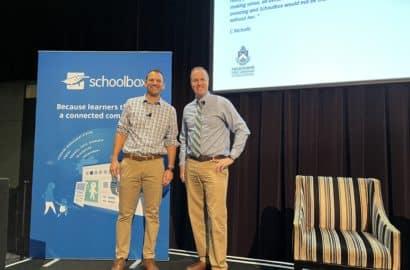
The topic of teacher burnout has been widely discussed throughout the last few years — and for good reason. A recent study from Gallup shows that K-12 teachers have the highest rate of burnout in any U.S. industry, with 44% reporting feeling “always” or “very often” burnt out. The combination of inadequate classroom resources, difficult students (and their parents), and a hefty workload all contribute to teacher burnout.
Luckily, technological advancements like ChatGPT are now available to help streamline classroom tasks and give teachers more time back in their day. (One popular YouTube video shows how teachers can use ChatGPT to complete an hour’s worth of work in just six minutes!) This blog will explore several ways teachers can harness ChatGPT to save time, mental energy, and boost creativity in their classrooms this upcoming school year.
Write a Welcome Letter
At the beginning of the school year, it’s common practice for teachers to send either an introductory email or welcome letter to their classroom families. The letter typically includes a friendly welcome message and information about what to expect in the coming year. While this is certainly a nice touch, it’s just one more thing to do before the first day of school!
With ChatGPT, you can take the busy work out of the letter writing process and generate a quality draft in mere seconds. Prompt the chatbot to “Write a welcome letter to [grade-level] parents at the beginning of the school year.” You can add some personality to the letter by peppering in a personal photo of you and your dog or sharing about an activity you did on your summer break.
Bonus: include a link to your student and parent portals so families know exactly where to go for information throughout the year.
Generate Ice Breaker Questions
Once the school year begins, it usually takes a few days for students to get comfortable with their new classroom, teacher, and classmates. Many teachers like to prepare get-to-know-you activities like ice breakers to help students acclimate to their new environment. This is another fun, but time-consuming, task. Enter ChatGPT!
Use the chatbot to “Write twenty funny ice breaker questions for [grade-level] students.” Almost instantly, you’ll get a list of questions that are sure to have your students LOLing together in no time. Simply copy and paste the questions into a blank document, press print, and then cut each question into its own slip of paper. Have students draw their own ice breaker from a bowl to make it even more engaging!
Create Journal Prompts
Similarly, some teachers incorporate journal activities into their classrooms to help students reflect on learning material or to practice their writing skills. Coming up with a fresh prompt each day, week, or even month can be challenging!
Ask ChatGPT to “Create a journal prompt for my [grade-level] [subject] class for each month from August – June.” You’ll get a wide range of seasonal prompts that are appropriate for your grade-level and give students a fun creative outlet.
You could use this same model for generating group discussion prompts, too.
Create a Lesson Plan
One of the most time-consuming tasks for teachers is lesson planning. Although labor-intensive, this process is critical for providing structure and clear learning objectives for your classroom. Luckily there’s a shortcut with, you guessed it, ChatGPT.
For instance, prompt the chatbot to “Write a semester-long lesson plan for a high school chemistry class about the periodic elements.” In return, you’ll get a weekly breakdown of key themes to discuss, primary objectives of the course, assessment criteria, and ideas for further student engagement. You can continue prompting ChatGPT to get more specific with your lesson plan outline, or you can use the prompt as a starting point and add your personal flair from there.
This prompt exercise can also be valuable for seasoned teachers who have used the same lesson plans for several years. Instead of racking your brain for ways to mix things up, you could take it to ChatGPT.
Draft Study Guide and Quiz Questions
Just as ChatGPT can help plan your lessons, it can also help you prepare students for assessments and even generate assessments directly.
For example, a high school English teacher might ask ChatGPT to “Write a ten-question study guide and accompanying quiz for a high school English class about The Great Gatsby.” The chatbot will draft a wide range of questions about key literary themes, characters, and symbolism from the book. It will then take the study guide material and turn it into a ten-question quiz for your students to complete.
Write Difficult Emails and Report Card Comments
Communication is key for resolving conflict with students and parents. Unfortunately, it can also be emotionally draining and time consuming to craft a thoughtful response to individual situations.
Try using ChatGPT! Prompt the chatbot to “Write an email to the parent of a child who is struggling in [grade-level] [subject] class.” The response will need some editing for clarity, but ChatGPT should provide a decent outline as the foundation of your email. Plus, it’ll save you mental energy and emotional stress.
You can also use this model for generating report card comments each semester.
Get Back to What You Love
Now that we’ve discussed some ways you can harness ChatGPT for your benefit, there’s a few parameters to keep in mind when using artificial intelligence:
- Be specific with your prompts: include grade-level, subject, curriculum, and any other details that might help narrow your results.
- Don’t include personally identifiable information in your chat prompts: you can fill those details in later, outside of the AI platform.
- Check with your technology team: many schools are adding AI policies to their academic integrity statements. Make sure you know where your school stands on these tools before incorporating them into your classroom.
- AI tools are here to help you, not replace you: use these tools as a starting point and efficiently booster, but review everything and be intentional about adding your personal thoughts and expressions.
This list represents a small fraction of the many ways artificial intelligence is empowering today’s teachers. We hope you can use these shortcuts in the coming academic year to save time and focus on what matters most: connecting with your students and preparing them for the future.



